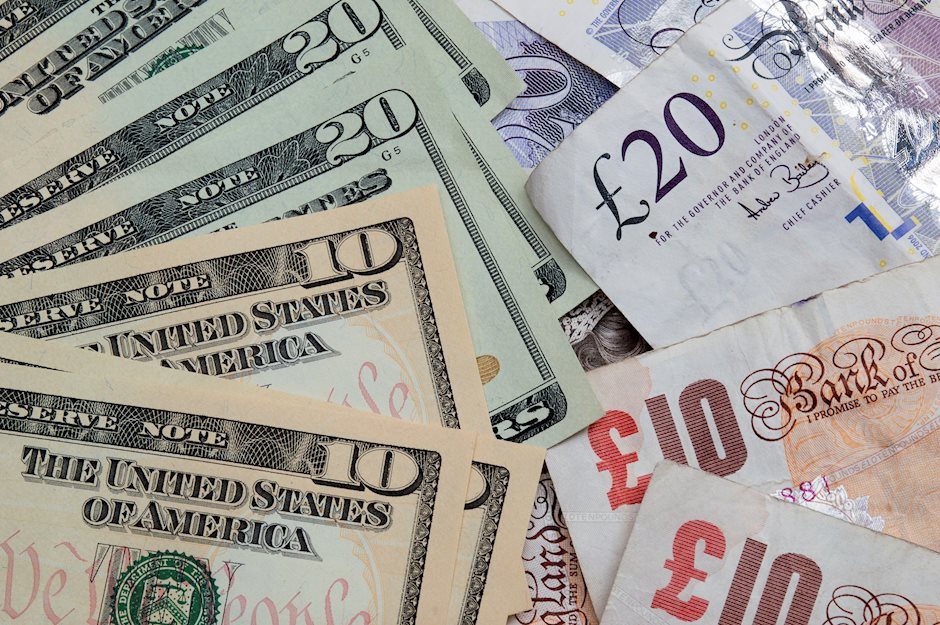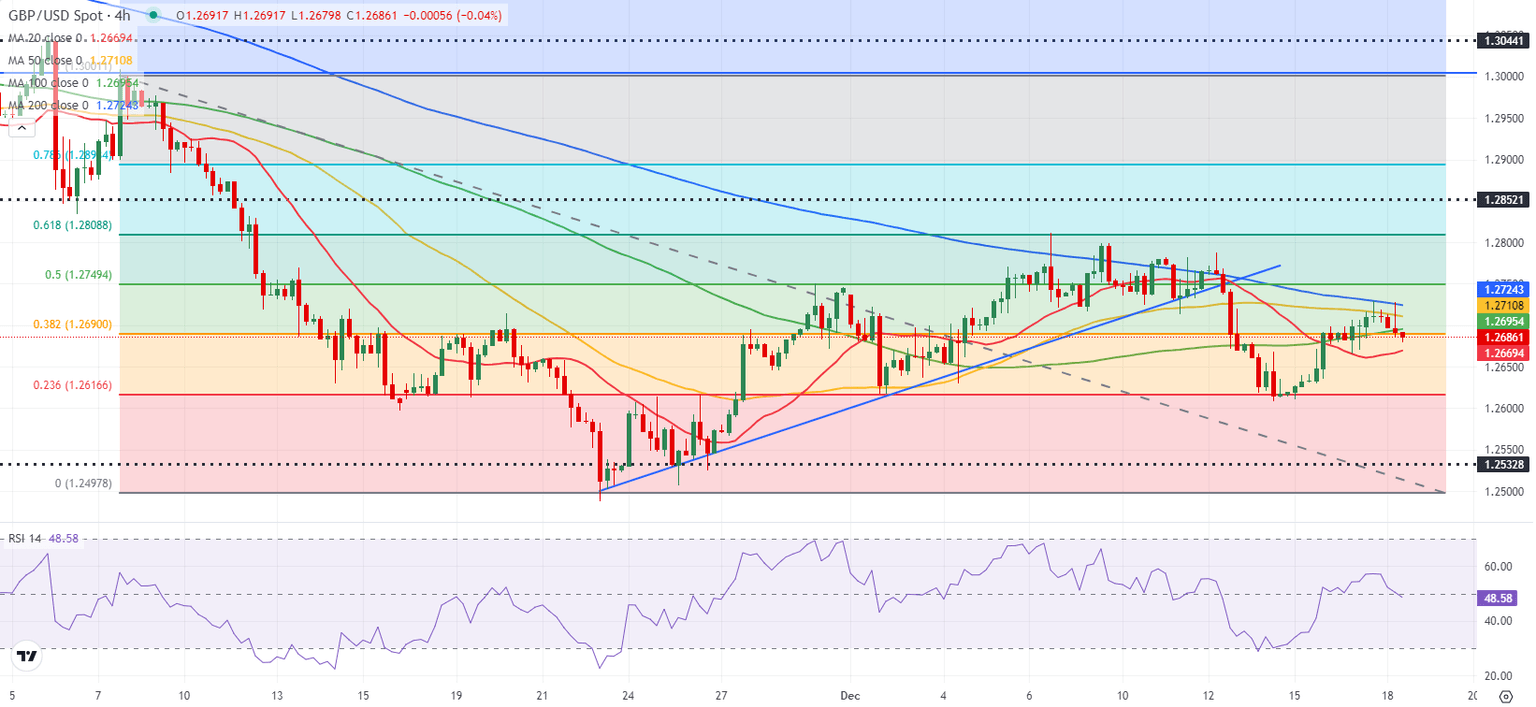GBP/USD Forecast: Pound Sterling ignores inflation data, focus shifts to Fed
- GBP/USD trades below 1.2700 in the European morning on Wednesday.
- Annual CPI inflation in the UK rose to 2.6% in November as expected.
- The Fed will announce the interest rate decision and publish the revised dot plot.

After closing the second consecutive day in positive territory on Tuesday, GBP/USD edges lower early Wednesday and trades below 1.2700. Investors eagerly await the Federal Reserve's (Fed) monetary policy announcements.
British Pound PRICE Last 7 days
The table below shows the percentage change of British Pound (GBP) against listed major currencies last 7 days. British Pound was the weakest against the US Dollar.
| USD | EUR | GBP | JPY | CAD | AUD | NZD | CHF | |
|---|---|---|---|---|---|---|---|---|
| USD | 0.29% | 0.67% | 1.18% | 1.06% | 1.03% | 1.16% | 1.22% | |
| EUR | -0.29% | 0.38% | 0.90% | 0.76% | 0.74% | 0.87% | 0.93% | |
| GBP | -0.67% | -0.38% | 0.49% | 0.38% | 0.35% | 0.48% | 0.54% | |
| JPY | -1.18% | -0.90% | -0.49% | -0.12% | -0.14% | -0.02% | 0.05% | |
| CAD | -1.06% | -0.76% | -0.38% | 0.12% | -0.02% | 0.10% | 0.16% | |
| AUD | -1.03% | -0.74% | -0.35% | 0.14% | 0.02% | 0.13% | 0.19% | |
| NZD | -1.16% | -0.87% | -0.48% | 0.02% | -0.10% | -0.13% | 0.07% | |
| CHF | -1.22% | -0.93% | -0.54% | -0.05% | -0.16% | -0.19% | -0.07% |
The heat map shows percentage changes of major currencies against each other. The base currency is picked from the left column, while the quote currency is picked from the top row. For example, if you pick the British Pound from the left column and move along the horizontal line to the US Dollar, the percentage change displayed in the box will represent GBP (base)/USD (quote).
The UK's Office for National Statistics reported in the European morning that annual inflation in the UK, as measured by the change in the Consumer Price Index (CPI), rose to 2.6% in November from 2.3% in October, as anticipated. The core CPI rose 3.5% on a yearly basis, up from the 3.3% increase recorded in October but below analysts' estimate of 3.6%. These figures failed to trigger a noticeable market reaction.
The Fed is set to cut the policy rate by 25 basis points (bps) to the range of 4.25%-4.5% following the last meeting of the year. As such a decision is already fully priced in, it is unlikely to influence the US Dollar's (USD) valuation in a significant way. Instead, investors will pay close attention to the revised Summary of Economic Projections (SEP), the so-called dot plot.
In case the dot plot suggests that policymakers project at least a rate reduction of 100 bps in 2025, the USD is likely to struggle to find demand. On the flip side, GBP/USD could turn south if the SEP shows that policymakers foresee less than 100 bps of rate cuts next year.
Starting at 19:30 GMT, Fed Chairman Jerome Powell will deliver the policy statement and respond to questions in a press conference. If Powell notes there is growing uncertainty surrounding the inflation outlook on potential tariffs, investors could see this as a sign that the Fed will adopt a more gradual approach to policy easing, boosting the USD.
GBP/USD Technical Analysis
GBP/USD faces immediate resistance at 1.2700 (100-period Simple Moving Average (SMA), Fibonacci 38.2% retracement of the latest downtrend) ahead of 1.2730 (200-period SMA) and 1.2750 (Fibonacci 50% retracement).
Looking south, first support could be spotted at 1.2670 (20-period SMA) before 1.2620 (Fibonacci 23.6% retracement).
Pound Sterling FAQs
The Pound Sterling (GBP) is the oldest currency in the world (886 AD) and the official currency of the United Kingdom. It is the fourth most traded unit for foreign exchange (FX) in the world, accounting for 12% of all transactions, averaging $630 billion a day, according to 2022 data. Its key trading pairs are GBP/USD, also known as ‘Cable’, which accounts for 11% of FX, GBP/JPY, or the ‘Dragon’ as it is known by traders (3%), and EUR/GBP (2%). The Pound Sterling is issued by the Bank of England (BoE).
The single most important factor influencing the value of the Pound Sterling is monetary policy decided by the Bank of England. The BoE bases its decisions on whether it has achieved its primary goal of “price stability” – a steady inflation rate of around 2%. Its primary tool for achieving this is the adjustment of interest rates. When inflation is too high, the BoE will try to rein it in by raising interest rates, making it more expensive for people and businesses to access credit. This is generally positive for GBP, as higher interest rates make the UK a more attractive place for global investors to park their money. When inflation falls too low it is a sign economic growth is slowing. In this scenario, the BoE will consider lowering interest rates to cheapen credit so businesses will borrow more to invest in growth-generating projects.
Data releases gauge the health of the economy and can impact the value of the Pound Sterling. Indicators such as GDP, Manufacturing and Services PMIs, and employment can all influence the direction of the GBP. A strong economy is good for Sterling. Not only does it attract more foreign investment but it may encourage the BoE to put up interest rates, which will directly strengthen GBP. Otherwise, if economic data is weak, the Pound Sterling is likely to fall.
Another significant data release for the Pound Sterling is the Trade Balance. This indicator measures the difference between what a country earns from its exports and what it spends on imports over a given period. If a country produces highly sought-after exports, its currency will benefit purely from the extra demand created from foreign buyers seeking to purchase these goods. Therefore, a positive net Trade Balance strengthens a currency and vice versa for a negative balance.
Premium
You have reached your limit of 3 free articles for this month.
Start your subscription and get access to all our original articles.
Author

Eren Sengezer
FXStreet
As an economist at heart, Eren Sengezer specializes in the assessment of the short-term and long-term impacts of macroeconomic data, central bank policies and political developments on financial assets.


















